Why Workmates by HR Cloud Stands Out: Best Recognition Tool to Drive Employee Motivation
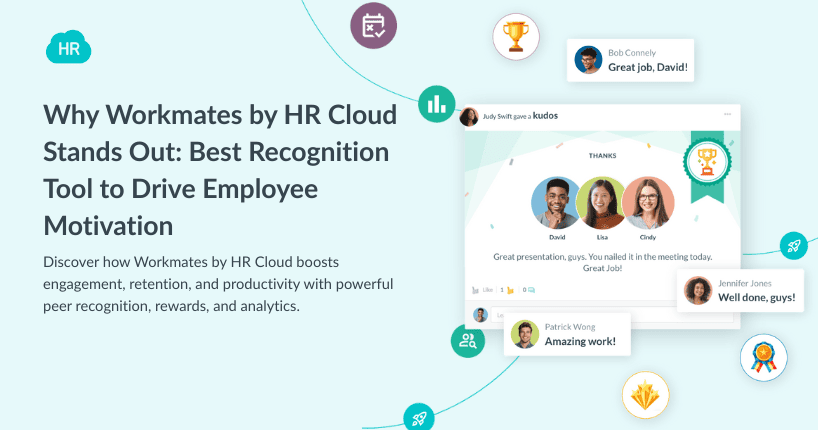
- The Psychology Behind Effective Recognition: Why Digital Platforms Outperform Traditional Methods
- Workmates Recognition Features: Best-in-Class Employee Appreciation Software
- Where Competitors Fall Short: Common Recognition Platform Challenges
- Real-World Impact: How Recognition Drives Results
- Implementation Best Practices: Making Recognition Stick in Your Organization
- Measuring Recognition ROI: Business Impact Data and Analytics
- Future-Proofing Recognition Strategy
- Addressing Common Recognition Challenges

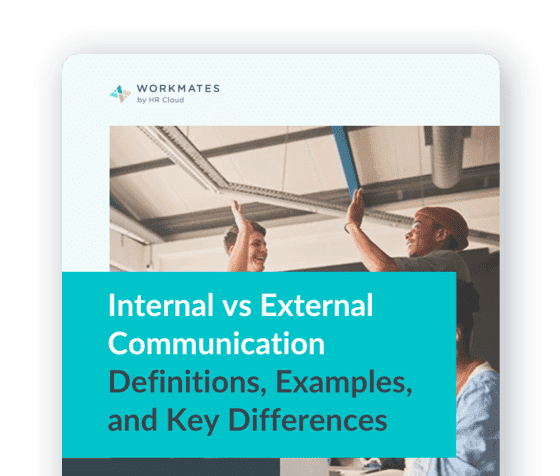
 Cut onboarding time
by 60%—here's the
Ultimate Checklist
that helped do it.
Cut onboarding time
by 60%—here's the
Ultimate Checklist
that helped do it.
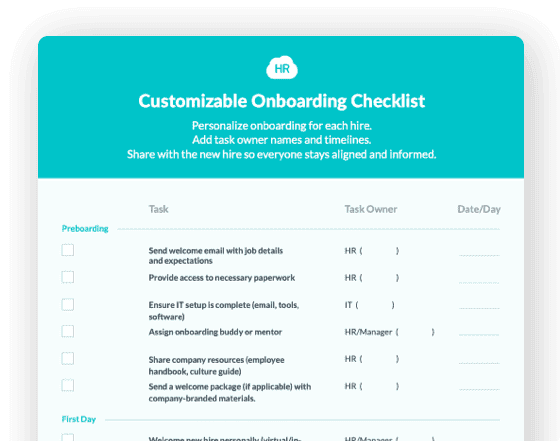
Workmates by HR Cloud delivers comprehensive peer-to-peer recognition through customizable kudos, points-based rewards, and seamless integrations that boost employee engagement. Unlike many competitors, it combines recognition with communication and analytics in one platform, supporting both office and frontline workers through mobile-first design. Companies using online recognition platforms see 2x higher productivity compared to internal programs, and 60% of online platform users report better business outcomes than offline alternatives.
Key Takeaways
-
Recognition drives retention: Well-recognized employees are 45% less likely to leave within two years, while lack of recognition causes 66% of employees to consider quitting
-
Online platforms outperform: Only 30% of HR leaders with internal programs see business results, compared to 60% with online solutions
-
ROI is measurable: Recognition software provides 300-500% ROI within 12-18 months for large enterprises, with strategic recognition investments yielding 5-7x returns
-
Frequency matters: Employees receiving monthly recognition report 2x higher productivity than those recognized less often
-
Mobile access is critical: Frontline and distributed teams need mobile-first recognition tools to participate meaningfully in company culture
Recognition isn't just about making people feel good anymore. It's become a measurable business strategy that directly impacts workforce retention, employee productivity, and organizational profitability. According to recent research, 90% of employees are more likely to put in extra effort when their work gets noticed, yet only 27% say recognition feels consistent and genuine in their workplace.
The employee recognition software market is experiencing unprecedented growth, with the global market reaching USD 1.0 billion in 2023 and projected to reach USD 3.8 billion by 2033. This expansion reflects organizations' growing understanding that digital recognition platforms deliver superior results compared to traditional appreciation methods.
Ready to transform your recognition strategy? Schedule a demo with HR Cloud to see Workmates in action.
The challenge? Most companies treat employee appreciation software as an afterthought rather than a systematic approach to workforce engagement. While 91% of organizations have some form of recognition program, only 31% rate their program's effectiveness as "high" or "very high." This effectiveness gap explains why many staff recognition systems fail to deliver measurable business outcomes.
Recognition platforms for employees must address multiple workforce challenges: distributed teams lacking connection, frontline workers feeling undervalued, managers struggling with consistent appreciation practices, and HR leaders needing data-driven insights into engagement patterns. According to SHRM research, companies with strategic recognition programs see 31% lower voluntary turnover, making systematic appreciation essential for talent retention. Traditional recognition approaches - annual awards ceremonies, manager-dependent praise, email acknowledgments - cannot address these complex workplace dynamics.
Workmates by HR Cloud bridges this gap by integrating peer to peer recognition software into daily workflows, making workplace appreciation both frequent and meaningful. But here's what sets this employee engagement platform apart: it's not just another points-and-rewards system. It's a comprehensive digital recognition platform that treats appreciation as part of a broader communication and culture strategy, delivering the workforce motivation software capabilities modern organizations require.
The Psychology Behind Effective Recognition: Why Digital Platforms Outperform Traditional Methods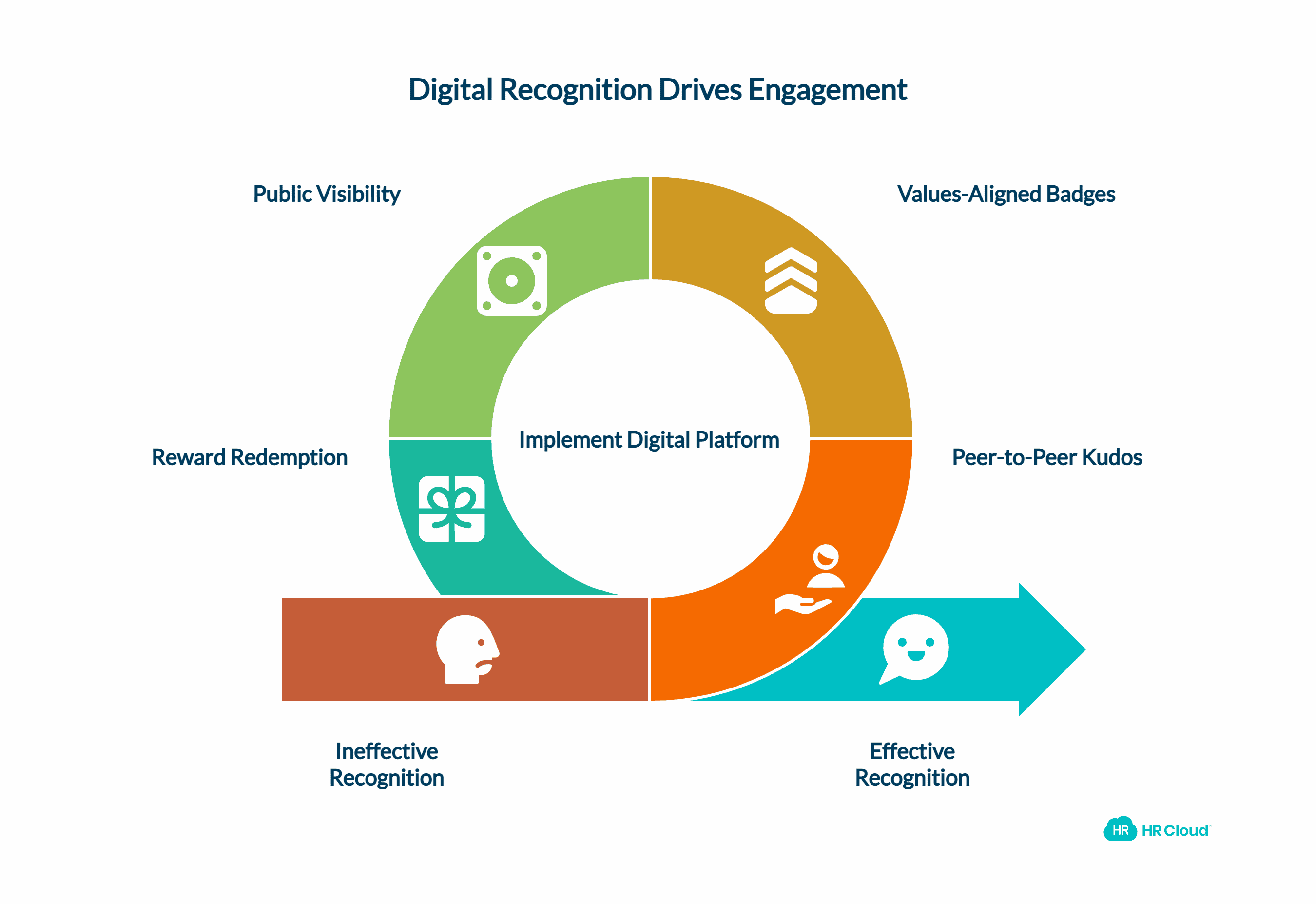
Think about the last time someone publicly acknowledged your work. Not just a private "thanks," but genuine recognition that others could see and appreciate. That feeling? It's backed by solid psychology and even better business outcomes that make employee recognition software essential for modern workplaces.
Research consistently shows that employees who feel recognized are four times more likely to be engaged and five times more likely to stay with their organization. The key isn't just saying "thank you" - it's creating visible, values-driven appreciation that reinforces the behaviors you want to see repeated across your workforce.
Why Peer-to-Peer Recognition Drives Superior Results
Peer to peer recognition amplifies psychological impact through several mechanisms:
Social Validation: When colleagues celebrate each other's wins, it builds trust, strengthens team bonds, and creates a culture where everyone feels empowered to contribute. This social proof carries more weight than manager-directed praise.
Behavioral Reinforcement: Recognition platforms for employees that make appreciation visible create behavioral modeling opportunities. Teams see which actions get celebrated and naturally adjust their own approaches. McKinsey research shows that non-financial recognition, such as public acknowledgment, increases engagement by 29%, making visibility a key factor in program effectiveness.
Cultural Integration: Staff recognition systems that operate through daily workflows - not separate appreciation events - embed positive behaviors into organizational culture more effectively.
Psychological Safety: Employee appreciation software that enables peer recognition creates psychological safety by distributing recognition authority beyond management hierarchies.
The difference between effective and ineffective recognition lies in frequency, specificity, and social visibility. Traditional methods - annual awards ceremonies, periodic manager feedback, generic appreciation emails - cannot deliver the consistent reinforcement that drives lasting behavioral change.
Digital Recognition Platform Advantages Over Traditional Approaches
Modern workforce motivation software addresses fundamental limitations of traditional recognition:
Frequency: Digital platforms enable daily appreciation rather than quarterly recognition ceremonies
Visibility: Social feeds make recognition visible across the organization, amplifying impact
Measurement: Employee engagement platforms provide analytics that traditional methods cannot track
Accessibility: Mobile recognition apps ensure all workers - frontline, remote, distributed - can participate equally
Consistency: Automated recognition workflows reduce manager dependency and recognition gaps
Recognition Impact Framework
|
Recognition Element |
Employee Behavior Impact |
Key Metrics |
Platform Advantage |
|
Peer-to-peer kudos |
Increased collaboration & team cohesion |
Participation rates, cross-department recognition |
Real-time social validation |
|
Values-aligned badges |
Reinforced company culture & behaviors |
Badge distribution, values adoption metrics |
Behavioral reinforcement tracking |
|
Public visibility |
Enhanced motivation & role modeling |
Social feed engagement, recognition frequency |
Organization-wide culture building |
|
Reward redemption |
Tangible appreciation & motivation |
Points balance, reward catalog usage |
Measurable appreciation impact |
Workmates Recognition Features: Best-in-Class Employee Appreciation Software
Comprehensive Peer-to-Peer Recognition with Custom Badges
Workmates makes workplace appreciation personal and meaningful through customizable kudos that align with company values. This employee recognition platform enables seamless peer to peer recognition through multiple recognition formats designed for modern workforce dynamics:
Individual Achievement Recognition: Targeted kudos for specific accomplishments with values-aligned badges
Team Collaboration Celebration: Group recognition for collaborative wins and cross-departmental projects
Milestone Appreciation: Automated celebrations for birthdays, work anniversaries, and career achievements
Real-Time Spot Recognition: Immediate appreciation for in-the-moment contributions and behaviors
What distinguishes this staff recognition system from competitors? The integration with broader organizational communication. Recognition doesn't happen in isolation - it becomes part of the company conversation through Workmates' social feed, creating continuous culture reinforcement.
The custom badge system transforms generic appreciation into culture-building tools. Instead of basic "great job" recognition, organizations can create badges like "Innovation Champion," "Customer Advocate," or "Team Collaborator" that reinforce specific behaviors and values critical to business success.
Points-Based Employee Rewards Platform That Drives Engagement
While many recognition platforms for employees offer generic gift card catalogs, Workmates provides both traditional rewards and custom options that reflect organizational culture and employee preferences. This comprehensive employee rewards platform supports:
Gift Card Integration: Major retailers, restaurants, and services through established partnerships
Custom Reward Creation: Company-specific rewards tailored to workforce demographics and cultural preferences
Charitable Giving Options: Social impact choices for values-driven employee appreciation
Experience Rewards: Company events, team activities, and professional development opportunities
Non-Monetary Recognition: Preferred parking, flexible work arrangements, and recognition-based privileges
The points-based system operates with complete transparency and administrative flexibility. HR teams can configure spending limits, establish approval workflows, and analyze reward redemption patterns to optimize program effectiveness over time. This level of customization ensures the employee appreciation software aligns with both budget constraints and cultural objectives.
Interested in customizing rewards for your team culture? Connect with HR Cloud to explore options.
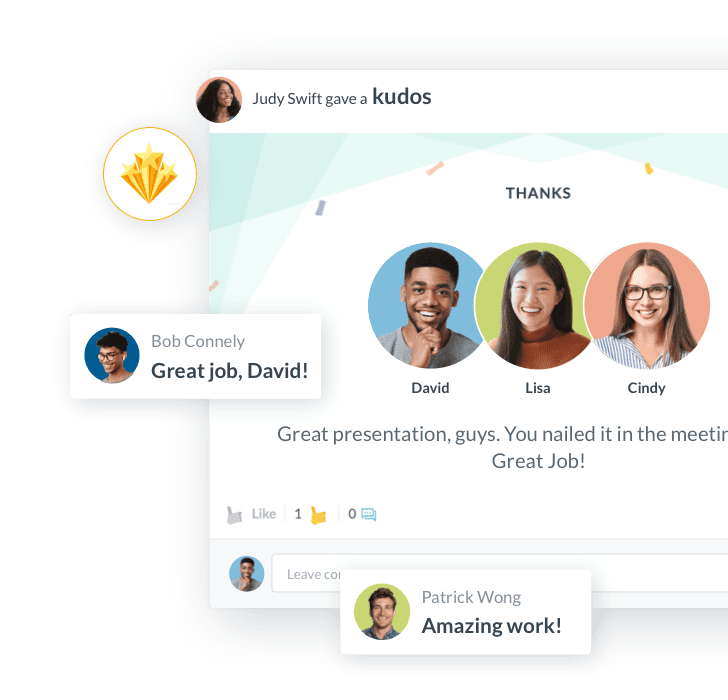
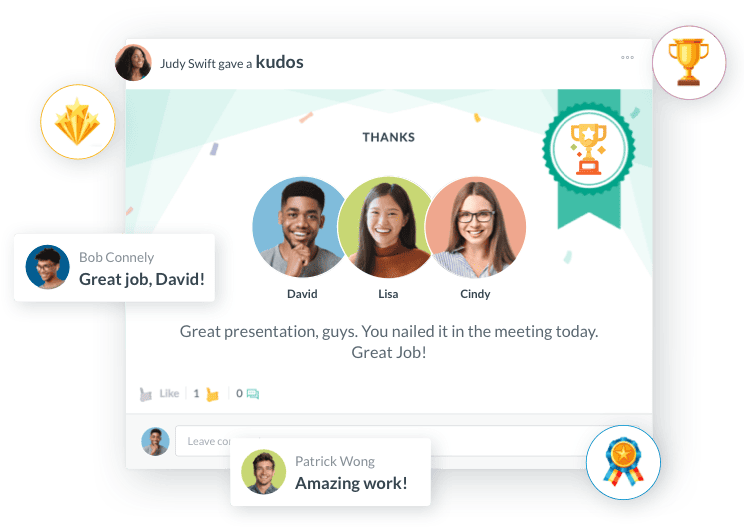
Advanced Recognition Analytics for Strategic Decision Making
Here's where Workmates separates itself from basic team recognition tools. The analytics dashboard doesn't just count kudos - it reveals patterns that help leaders make informed decisions about culture, engagement, and retention through comprehensive workforce analytics.
Recognition Frequency Analysis: Department and location-based participation tracking
Values Alignment Metrics: Badge distribution analysis revealing cultural behavior patterns
Engagement Correlation: Recognition trends connected to business performance indicators
Participation Equity: Identification of recognition gaps and culture champion behaviors
ROI Measurement: Quantifiable impact of recognition investment on retention and productivity
This data transforms employee recognition software from a feel-good initiative into a strategic culture tool. HR teams can identify low-engagement areas before they become retention problems and replicate successful recognition patterns across the organization.
The analytics capabilities enable evidence-based optimization of recognition programs, ensuring continuous improvement in workforce motivation and engagement outcomes.
Mobile-First Design for Distributed Workforce Recognition
With hybrid and remote work now standard, mobile accessibility isn't optional for effective employee engagement platforms. Workmates provides full-featured iOS and Android applications that make peer to peer recognition as easy as sending a text message.
Frontline workers, field teams, and remote employees can participate equally in company recognition programs through mobile workforce motivation software that includes:
One-Touch Recognition: Quick kudos with preset messages and values-aligned badges
Rich Media Support: Photo and video attachments for enhanced recognition storytelling
Push Notification Engagement: Real-time alerts for recognition activities and team celebrations
Mobile Accessibility: Recognition apps designed for frontline workers and field teams with varying connectivity
Multilingual Support: Global workforce recognition in multiple languages and cultural contexts
This mobile-first approach ensures recognition platform accessibility across all employee populations, eliminating the digital divide that often excludes frontline workers from corporate appreciation programs.
Seamless HRIS Integration for Unified Employee Experience
Enterprise-grade employee recognition software requires deep integration with existing HR technology infrastructure. Workmates provides documented integration capabilities with major HRIS platforms including:
ADP Integration: Automatic employee data synchronization and recognition analytics integration
Workday Connectivity: Unified employee experience with seamless data flow between systems
UKG Integration: Comprehensive workforce management and recognition platform alignment
Custom API Access: Flexible integration options for proprietary or specialized HR systems
These integrations eliminate data silos and administrative overhead while providing unified reporting capabilities that connect recognition metrics to broader HR analytics and business outcomes.
Platform Comparison: Workmates vs Competitors
|
Feature |
Workmates (HR Cloud) |
Bonusly |
Nectar |
Workhuman |
Lattice |
|
Peer Recognition |
★★★★★ Full social feed |
★★★★☆ Public recognition |
★★★★☆ Team shoutouts |
★★★★☆ Social recognition |
★★☆☆☆ Limited |
|
Custom Rewards |
★★★★★ Gift cards + custom |
★★☆☆☆ Limited catalog |
★★☆☆☆ Basic options |
★★★★☆ Global catalog |
★☆☆☆☆ No rewards |
|
Mobile App |
★★★★★ Full-featured |
★★★★☆ Good mobile |
★★★★★ Mobile-first |
★★★★☆ Comprehensive |
★★☆☆☆ Basic |
|
Analytics |
★★★★★ Engagement insights |
★★☆☆☆ Basic reporting |
★★☆☆☆ Limited data |
★★★★☆ Advanced (complex) |
★★★☆☆ Performance-focused |
|
Communication Hub |
★★★★★ Integrated platform |
★☆☆☆☆ Recognition only |
★☆☆☆☆ Recognition only |
★★☆☆☆ Limited |
★☆☆☆☆ Performance-focused |
|
HRIS Integration |
★★★★★ ADP, Workday, UKG+ |
★★☆☆☆ Basic integrations |
★★☆☆☆ HR system sync |
★★★★☆ Enterprise grade |
★★☆☆☆ Limited |
|
Implementation |
★★★★★ Guided onboarding |
★★★★☆ Easy setup |
★★★★☆ Quick start |
★★☆☆☆ Complex enterprise |
★★☆☆☆ Admin-heavy |
Where Competitors Fall Short: Common Recognition Platform Challenges
Understanding competitor limitations helps explain why many organizations struggle with recognition program effectiveness despite widespread adoption. Based on documented user reviews and platform analysis, here are the key weaknesses affecting popular employee recognition platforms:
Bonusly: Support and Technical Limitations
While Bonusly offers an intuitive peer to peer recognition system, users frequently cite significant operational challenges:
Support Response Issues: Multiple G2 reviews highlight delayed or inadequate customer support responses, with users reporting "customer support responded promptly, but without an actual solution" and "too bad it has not worked properly in a while."
Limited Analytics Depth: The platform provides basic recognition tracking but lacks comprehensive workforce analytics that connect recognition patterns to business outcomes like retention and productivity.
Reward Catalog Constraints: Users express frustration with the limited reward selection and high point requirements for meaningful redemptions, reducing program participation over time.
Integration Complexity: While marketed as easy to integrate, users report ongoing technical issues that impact daily recognition workflows and user adoption.
Nectar: Scope and Competitive Culture Concerns
Nectar positions itself as a mobile-first recognition solution but faces documented challenges in program effectiveness:
Limited Recognition Analytics: The platform offers basic reporting without the depth needed for strategic workforce planning and recognition optimization.
Competitive Rather Than Collaborative Culture: Users note that the platform "promotes a culture of competition" rather than genuine collaboration, potentially undermining team cohesion.
Restricted Reward Options: Despite marketing comprehensive rewards, users report a "small catalog" that limits meaningful recognition choices for diverse workforces.
Favoritism Amplification: Reviews indicate the platform makes under-recognition obvious, with users reporting "when someone is not recognized it is very obvious and people often feel left out" and "encourages favoritism."
Workhuman: Enterprise Complexity and Cost Barriers
Workhuman offers sophisticated recognition capabilities but creates significant implementation and operational challenges:
Implementation Complexity: The platform requires extensive enterprise-level setup that many organizations find overwhelming, with users reporting complex configuration processes that delay program launch.
Cost Escalation: Enterprise pricing models often exceed budget expectations, particularly for mid-sized organizations seeking comprehensive recognition capabilities without enterprise-level complexity.
Administrative Overhead: The platform's advanced features require dedicated administrative resources that smaller HR teams cannot sustain effectively.
Over-Engineering for Simple Needs: Some organizations find Workhuman’s enterprise-focused feature set heavier than they need for straightforward peer recognition and appreciation programs.
Lattice: Performance Focus Over Recognition Culture
Lattice primarily serves as a performance management platform with limited recognition capabilities:
Secondary Recognition Features: Recognition functions as an add-on rather than a core platform capability, resulting in limited engagement and adoption.
Complex Administrative Setup: Users report significant administrative burden and complex configuration requirements that discourage recognition program participation.
Limited Reward Integration: The platform lacks comprehensive reward management and redemption capabilities essential for effective staff recognition systems.
Performance Management Bias: The platform's performance-centric approach can make recognition feel evaluative rather than appreciative, reducing psychological safety and authentic peer appreciation.
Based on user reviews and platform comparisons, here's what sets Workmates apart:
Competitive Advantages:
-
Recognition embedded in communication platform rather than standalone tool
-
Customizable reward store that adapts to company culture
-
Analytics that connect recognition to business outcomes
-
Mobile experience designed for frontline workers
-
Integration depth with major HRIS platforms
Areas for Consideration:
-
Initial setup requires HRIS integration planning
-
Feature richness may create learning curve for administrators
-
Points system requires budget planning for sustainable rewards
Real-World Impact: How Recognition Drives Results
Industry Case Study: Manufacturing Excellence
Consider a mid-sized manufacturing company struggling with recognition consistency across shift workers. Traditional approaches - manager shout-outs during meetings, employee-of-the-month programs - reached maybe 20% of the workforce.
After implementing Workmates, here's what changed:
-
85% employee participation in recognition activities within 90 days
-
40% increase in cross-shift recognition, building stronger team connections
-
60% reduction in safety incidents, correlated with increased recognition for safety behaviors
-
15% improvement in retention among frontline workers
The key? Mobile access and values-aligned badges that celebrated the behaviors most important to operational success. Workers could recognize teammates immediately after observing good safety practices or collaborative problem-solving.
Want to explore recognition strategies for your industry? Book a consultation with HR Cloud experts.
Measuring Recognition ROI
Smart organizations track recognition impact through multiple lenses. Here's a framework for measuring success:
|
Metric Category |
Key Indicators |
Workmates Tracking |
|
Participation |
Active users, kudos frequency, reward redemption |
Real-time dashboard analytics |
|
Culture Alignment |
Values-based recognition, peer participation |
Badge distribution reports |
|
Business Impact |
Engagement scores, retention rates, productivity |
HRIS integration insights |
|
Program Health |
Recognition distribution, manager participation |
Equity and engagement analysis |
Implementation Best Practices: Making Recognition Stick in Your Organization
Successful employee recognition software implementation requires strategic planning that addresses both technical integration and cultural adoption. Based on HR Cloud's experience implementing recognition platforms for employees across diverse industries, here's a proven framework for maximizing recognition program effectiveness.
Phase 1: Foundation Building (Weeks 1-4)
Comprehensive Culture Assessment Start by conducting thorough analysis of your current workplace appreciation landscape:
-
Map existing recognition practices across departments and locations
-
Identify teams with strong peer connection and collaboration patterns
-
Document recognition gaps affecting employee engagement and retention
-
Survey workforce preferences for meaningful appreciation and rewards
Strategic Value Alignment Transform company values into actionable recognition framework:
-
Map organizational values to specific recognition badges and categories
-
Create values-aligned appreciation language that reinforces desired behaviors
-
Design recognition criteria that connect to business objectives and performance metrics
-
Establish measurement frameworks that track cultural alignment over time
Pilot Program Design Launch employee appreciation software with representative workforce groups:
-
Select pilot participants including recognition champions and potential skeptics
-
Establish baseline metrics for engagement, participation, and satisfaction
-
Create feedback loops for continuous program refinement and optimization
-
Document early wins and challenges for broader rollout planning
Phase 2: Scaled Adoption (Months 2-3)
Manager Enablement and Training Equip leadership with recognition psychology and platform expertise:
-
Train managers on recognition best practices and behavioral psychology principles
-
Provide guidelines for public versus private appreciation strategies
-
Establish recognition frequency standards that drive engagement without overwhelming workflows
-
Create manager accountability metrics for consistent team appreciation
Multi-Channel Communication Strategy Use comprehensive communication approach to reinforce recognition culture:
-
Leadership modeling through visible participation in peer to peer recognition
-
Success story sharing across organizational communication channels
-
Integration with existing company communication platforms and workflows
-
Regular milestone celebrations that reinforce program value and participation
Continuous Feedback Integration Gather user insights and optimize employee recognition platform accordingly:
-
Regular user surveys focusing on platform usability and recognition satisfaction
-
Badge category optimization based on actual usage patterns and cultural relevance
-
Reward catalog adjustments reflecting employee preferences and redemption data
-
Communication approach refinement based on engagement analytics and user feedback
Phase 3: Optimization and Scale (Ongoing)
Data-Driven Program Refinement Leverage workforce motivation software analytics for continuous improvement:
-
Recognition pattern analysis to identify optimal frequency and timing strategies
-
Participation equity assessment ensuring inclusive recognition across all employee populations
-
Correlation analysis connecting recognition metrics to retention, engagement, and productivity outcomes
-
Analytics that help HR teams identify recognition participation patterns and engagement trends, enabling proactive responses to low-engagement areas
Program Evolution and Enhancement Adapt staff recognition system to organizational growth and change:
-
Regular program reviews ensuring continued relevance to business objectives and workforce needs
-
Recognition category expansion based on evolving company values and business priorities
-
Integration enhancement with new HR technology and communication platforms
-
Cultural adaptation for geographic expansion or acquisition integration
Strategic Business Integration Connect employee engagement platform outcomes to broader organizational objectives:
-
Recognition impact measurement on key business metrics including retention, productivity, and customer satisfaction
-
ROI analysis demonstrating recognition program value to executive leadership and board stakeholders
-
Integration with performance management, career development, and succession planning initiatives
-
Expansion planning for additional engagement features and workforce development capabilities
Common Implementation Challenges and Solutions
Challenge: Low Initial Participation Rates Solution: Create recognition champions program with early adopters who model desired behaviors and encourage peer participation through organic influence
Challenge: Recognition Fatigue or Perceived Insincerity Solution: Establish recognition quality standards focusing on specific, timely, and values-aligned appreciation rather than generic acknowledgment
Challenge: Management Resistance or Skepticism Solution: Provide compelling business case with ROI projections and competitor analysis demonstrating recognition platform necessity for talent retention
Challenge: Technical Integration Complexity Solution: Leverage HR Cloud's implementation expertise and HRIS integration specialists to ensure seamless system connectivity and data flow
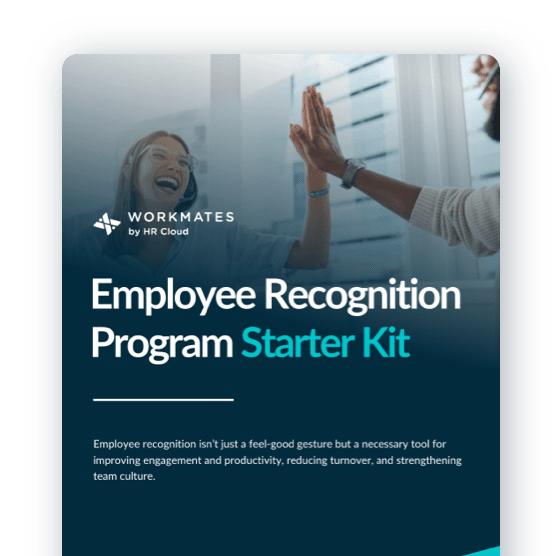

Measuring Recognition ROI: Business Impact Data and Analytics
Quantifiable Business Outcomes from Employee Recognition Software
Effective workforce motivation software delivers measurable financial impact through multiple business metrics that directly affect organizational profitability and competitive positioning. Based on comprehensive research across thousands of organizations, here are the documented ROI patterns from strategic recognition platform implementation:
Employee Retention Impact
-
Well-recognized employees are 45% less likely to leave within two years
-
Organizations with strategic recognition programs see 31% lower voluntary turnover
-
Companies implementing recognition software reduce turnover by up to 49% in documented case studies
Productivity and Performance Metrics
-
Recognition-driven cultures achieve 21% higher productivity compared to organizations without systematic appreciation
-
Employees receiving monthly recognition report 2x higher productivity than those recognized less frequently
-
Well-recognized employees are 2.5 times more likely to be happy with their jobs
Financial Return on Investment
-
Recognition software implementations deliver 300-500% ROI within 12-18 months for large enterprises
-
Strategic recognition investments produce 5-7x returns in performance improvements
-
Every $1 spent on recognition yields $5-7 in measurable business outcomes
Recognition Investment Framework for Maximum Impact
|
Investment Level |
Employee Population |
Expected ROI Timeline |
Key Success Metrics |
|
$2-4 per employee/month |
Small to medium business |
6-12 months |
Engagement scores, retention rates |
|
$5-8 per employee/month |
Mid-market organizations |
12-18 months |
Productivity metrics, culture scores |
|
$10+ per employee/month |
Enterprise implementations |
18-24 months |
Revenue per employee, market position |
Real-World Impact: Industry Case Study Analysis
Healthcare Organization Results A 2,000-employee healthcare system implementing Workmates employee recognition software achieved:
-
60% reduction in nurse turnover within 18 months
-
40% improvement in patient satisfaction scores correlated with staff recognition
-
$2.3 million annual savings in recruitment and training costs
-
85% employee participation in peer to peer recognition programs
Manufacturing Excellence Case Study Mid-sized manufacturing company with distributed workforce:
-
85% employee participation in recognition activities within 90 days
-
40% increase in cross-shift recognition building stronger team connections
-
60% reduction in safety incidents correlated with recognition for safety behaviors
-
15% improvement in retention among frontline workers
Want to explore recognition ROI for your industry? Book a consultation with HR Cloud experts.

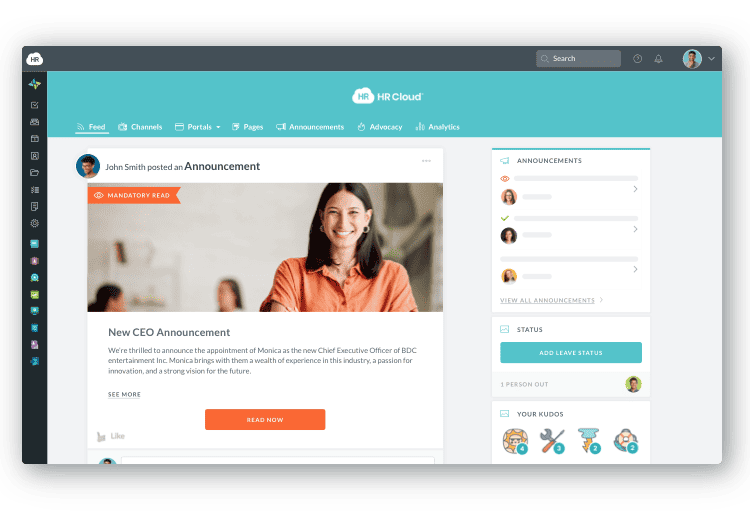
Employee Engagement Platform Analytics That Drive Business Decisions
Modern staff recognition systems provide comprehensive data that enables evidence-based culture management and strategic workforce planning:
Participation Analytics
-
Real-time recognition frequency tracking across departments and locations
-
Peer to peer recognition distribution analysis revealing team dynamics
-
Manager participation assessment identifying leadership engagement gaps
-
Employee satisfaction correlation with recognition patterns
Cultural Impact Measurement
-
Values alignment tracking through badge distribution and usage patterns
-
Cross-departmental collaboration metrics via recognition exchanges
-
Culture champion identification through high-participation employee analysis
-
Recognition equity assessment ensuring inclusive appreciation across all populations
Business Performance Correlation
-
Recognition frequency correlation with retention rates and exit interview data
-
Productivity measurement integration with appreciation timing and frequency
-
Customer satisfaction correlation with employee recognition participation
-
Revenue per employee analysis connected to recognition program engagement
Harvard Business Review research demonstrates that employees working for leaders who provide above-average recognition report significantly higher engagement levels, confirming the strategic importance of systematic appreciation programs for business performance.
This comprehensive analytics approach transforms employee appreciation software from subjective culture initiative to data-driven business strategy with measurable outcomes and continuous optimization capabilities.
Future-Proofing Recognition Strategy
Emerging Trends in Employee Recognition
The recognition landscape continues evolving beyond simple peer-to-peer platforms. Forward-thinking organizations are integrating:
AI-Driven Insights: Predictive analytics that identify at-risk employees based on recognition patterns and suggest targeted appreciation strategies.
Values-Based Recognition: Moving beyond generic appreciation to culture-specific celebration that reinforces organizational priorities.
Cross-Generational Approaches: Recognition strategies that resonate with multiple generations in the workforce, from mobile-native approaches to more traditional celebration methods.
Integration Depth: Recognition woven into performance management, career development, and business outcome tracking rather than standalone appreciation programs.
How Workmates Positions for the Future
Workmates by HR Cloud is built on a platform architecture that supports evolving recognition needs:
-
API-first design enables integration with emerging workplace tools
-
Configurable workflows adapt to changing organizational structures
-
Mobile-responsive approach supports evolving work arrangements
-
Analytics foundation provides data infrastructure for AI-enhanced insights
Addressing Common Recognition Challenges
Challenge: "Recognition Feels Forced"
Workmates Solution: Instead of mandating recognition frequency, the platform creates natural opportunities through workflow integration. Recognition happens in context - when someone shares a project update, helps a colleague, or celebrates a milestone.
Challenge: "We Don't Have Budget for Rewards"
Workmates Approach: The platform supports both monetary and non-monetary recognition. Custom rewards can include preferred parking spots, flexible work arrangements, learning opportunities, or company experiences that cost little but mean a lot.
Challenge: "Our Team Is Too Busy for Another Platform"
Integration Strategy: Workmates recognition lives within existing workflows through Slack, Microsoft Teams, and other communication tools. Recognition becomes part of daily work rather than additional overhead.
Challenge: "Remote Workers Feel Left Out"
Mobile-First Inclusion: The Workmates mobile app ensures distributed team members can participate equally in recognition culture, with features designed specifically for frontline and remote workers.
FAQ: Employee Recognition Software Implementation and Best Practices
What exactly is Workmates by HR Cloud and how does it differ from other employee recognition platforms?
Workmates is a comprehensive employee engagement platform that integrates peer to peer recognition, communication, and workforce analytics in a unified solution. Unlike standalone recognition platforms for employees, it combines workplace appreciation with broader communication and culture building capabilities. The platform serves as both recognition software and employee engagement platform, providing social feeds, custom badge systems, points-based rewards, and advanced analytics that connect recognition patterns to business outcomes.
How does the Workmates peer to peer recognition system work for different types of employees?
The employee appreciation software operates through customizable kudos with values-aligned badges that employees can award to colleagues for specific achievements or behaviors. Recipients earn points redeemable for gifts, charitable donations, or custom company rewards. All recognition appears in a social feed that builds company culture visibility. The system works equally well for office workers, frontline employees, remote teams, and distributed workforces through mobile-first design and offline capability.
What types of businesses benefit most from Workmates employee recognition software?
Organizations ranging from small businesses to large enterprises across healthcare, manufacturing, retail, technology, and professional services sectors achieve success with Workmates. The platform particularly benefits companies with distributed workforces, frontline workers, remote teams, or organizations struggling with employee engagement and retention challenges. Best results come from companies committed to data-driven culture building and systematic approach to workplace appreciation.
Can Workmates employee engagement platform integrate with our existing HRIS or payroll system?
Yes, Workmates provides comprehensive integration with major HRIS platforms including ADP, Workday, UKG, BambooHR, and others through established APIs and custom integration capabilities. These connections enable automatic employee data synchronization, unified reporting, and streamlined administration. The integration eliminates data silos while providing analytics that connect recognition metrics to broader HR outcomes like retention, performance, and engagement.
How mobile-friendly is Workmates for frontline employees and distributed teams?
Workmates prioritizes mobile accessibility through full-featured iOS and Android applications designed specifically for frontline workers, remote teams, and employees without constant computer access. The mobile employee appreciation software includes one-touch recognition, rich media support, push notifications, offline capability, and multilingual support. This ensures equal participation across all employee populations regardless of work location or technology access.
What security measures does Workmates employee recognition platform provide?
The platform maintains enterprise-grade security standards including GDPR compliance, SOC 2 Type II certification, single sign-on (SSO) integration, role-based access controls, and data encryption. These security measures protect employee information while ensuring privacy and regulatory compliance across global operations. Regular security audits and updates maintain protection against emerging threats.
How do organizations measure ROI from Workmates staff recognition system?
The platform provides comprehensive analytics dashboards tracking engagement trends, recognition frequency, reward redemption patterns, and correlations with retention and performance metrics. Organizations typically measure ROI through reduced turnover costs, increased employee engagement scores, improved productivity metrics, and enhanced customer satisfaction ratings. Recognition software implementations typically deliver 300-500% ROI within 12-18 months through measurable improvements in workforce retention and engagement.
What reward options are available through Workmates employee rewards platform?
The system supports both traditional and custom rewards including gift cards for major retailers and restaurants, charitable giving options, company-branded merchandise, experience rewards, and non-monetary recognition like preferred parking or flexible work arrangements. Custom reward stores can be tailored to company culture, geographic locations, and employee preferences. The platform provides budget controls and spending limit management for sustainable program operation.
How quickly can organizations implement Workmates recognition platform for employees?
Typical implementation takes 2-4 weeks including HRIS integration setup, administrator training, custom badge creation, reward catalog configuration, and pilot program launch. HR Cloud provides dedicated onboarding specialists who ensure smooth adoption and early success. Implementation timeline varies based on organization size, integration complexity, and customization requirements.
Does Workmates employee recognition software work for global organizations?
Yes, Workmates is designed to support distributed workforces across multiple locations. For specific capabilities regarding multilingual support, international reward catalogs, and regional customization, contact HR Cloud to discuss your global deployment requirements.
How does Workmates compare to other workforce motivation software in terms of pricing and features?
Workmates typically provides superior value compared to enterprise platforms like Workhuman through comprehensive features without enterprise complexity, while offering more sophisticated analytics and integration than simple platforms like Bonusly or Nectar. Pricing varies based on organization size, feature requirements, and customization needs. The platform's combination of recognition, communication, and analytics often replaces multiple point solutions, improving total cost of ownership.
What training and support does HR Cloud provide for Workmates implementation?
HR Cloud offers comprehensive implementation support including dedicated customer success managers, administrator training programs, best practice consultation, technical integration assistance, and ongoing optimization guidance. Training covers recognition psychology, platform administration, analytics interpretation, and program optimization strategies. Continuous support ensures long-term program success and maximum ROI achievement.
Employee recognition software represents more than workplace nicety - it's become essential infrastructure for modern organizations competing for talent in challenging labor markets. While 94% of organizations have recognition programs, only 31% see high effectiveness because they treat workplace appreciation as an afterthought rather than a strategic culture tool with measurable business impact.
The difference between effective and ineffective recognition lies in platform sophistication, implementation strategy, and integration depth. Organizations achieving recognition success share common characteristics: they use employee engagement platforms that integrate with existing workflows, provide mobile access for all employee populations, deliver analytics connecting appreciation to business outcomes, and treat peer to peer recognition as part of comprehensive culture strategy.
Workmates by HR Cloud changes the recognition effectiveness equation by embedding appreciation into communication, workflows, and business analytics systems. The result? Employee appreciation software that feels natural, drives measurable engagement, and delivers quantifiable business impact through reduced turnover, increased productivity, and enhanced employee satisfaction.
Modern workforce challenges - distributed teams lacking connection, frontline workers feeling undervalued, managers struggling with consistent appreciation practices, and HR leaders needing data-driven culture insights - require sophisticated recognition platforms for employees that address multiple organizational needs simultaneously. Traditional recognition approaches cannot deliver the frequency, visibility, and measurement capabilities that drive lasting culture change and business results.
Ready to see how advanced employee recognition software can transform your workplace culture? Schedule a demo with HR Cloud to explore Workmates capabilities for your organization.
The question isn't whether recognition matters for employee engagement and retention - extensive research confirms its critical importance. The question is whether your staff recognition system is sophisticated enough to drive the engagement, productivity, and retention results your organization needs to compete effectively for talent. With the right employee recognition platform and implementation strategy, workplace appreciation becomes one of your most powerful tools for building the organizational culture that top performers choose to stay with.
Recognition done right delivers measurable ROI: 21% higher productivity, 31% lower voluntary turnover, and up to 500% return on investment within 18 months. Organizations that implement comprehensive recognition platforms for employees position themselves for sustainable competitive advantage through superior culture, engagement, and talent retention capabilities.
Transform your recognition strategy today. Contact HR Cloud to begin building a workplace culture that drives results.

Keep Reading
Why Workmates by HR Cloud Stands Out: Best Recognition Tool to Drive Employee Motivation
Workmates by HR Cloud delivers comprehensive peer-to-peer recognition through
Giant List of 100+ Employee Recognition Message Templates (Just Copy & Paste)
"Great job!" is the workplace equivalent of "We need to talk" — vague and unhelpful. And
Best Peer-to-Peer Recognition Software & Kudos Platforms (2025 Buyer's Guide)
Picture this: A manufacturing team in Ohio just hit their monthly safety record. In the
Like What You Hear?
We'd love to chat with you more about how HR Cloud® can support your business's HR needs. Book Your Free Demo

Build a Culture of Recognition. Boost Engagement. Guaranteed.
Workmates empowers employees to stay informed, connected, and appreciated—whether they’re on the front line, in the office, or remote. Recognition drives 12x higher engagement.Trusted by industry leaders in every sector




Cut Onboarding Costs by 60%.
Take the confusion and follow-ups out of onboarding with automated workflows, digital forms, and structured portals—so new hires ramp faster 3X quicker.Trusted by industry leaders in every sector




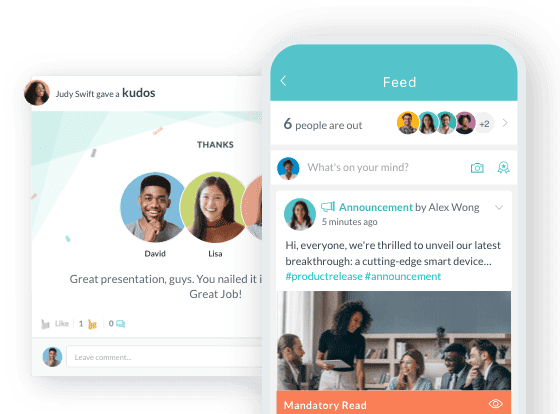

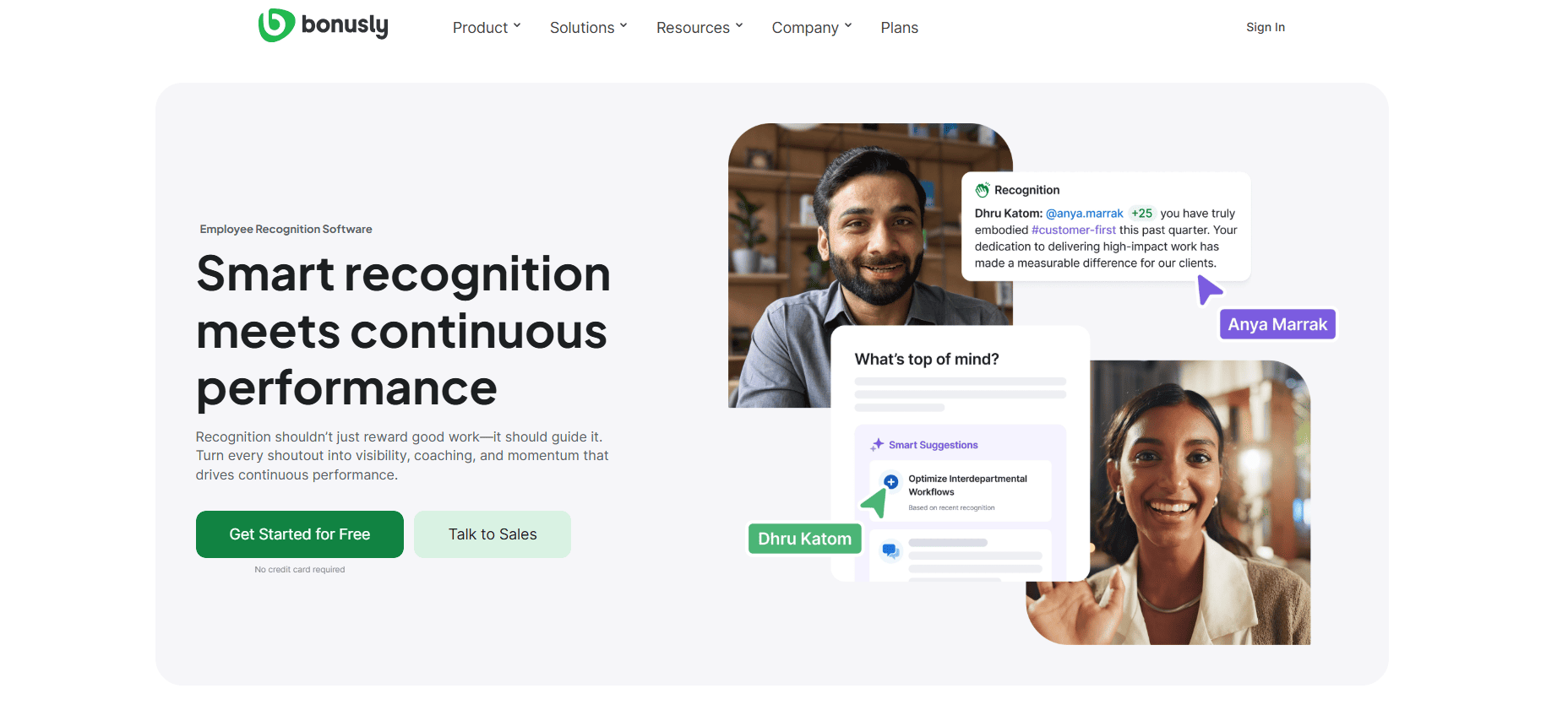
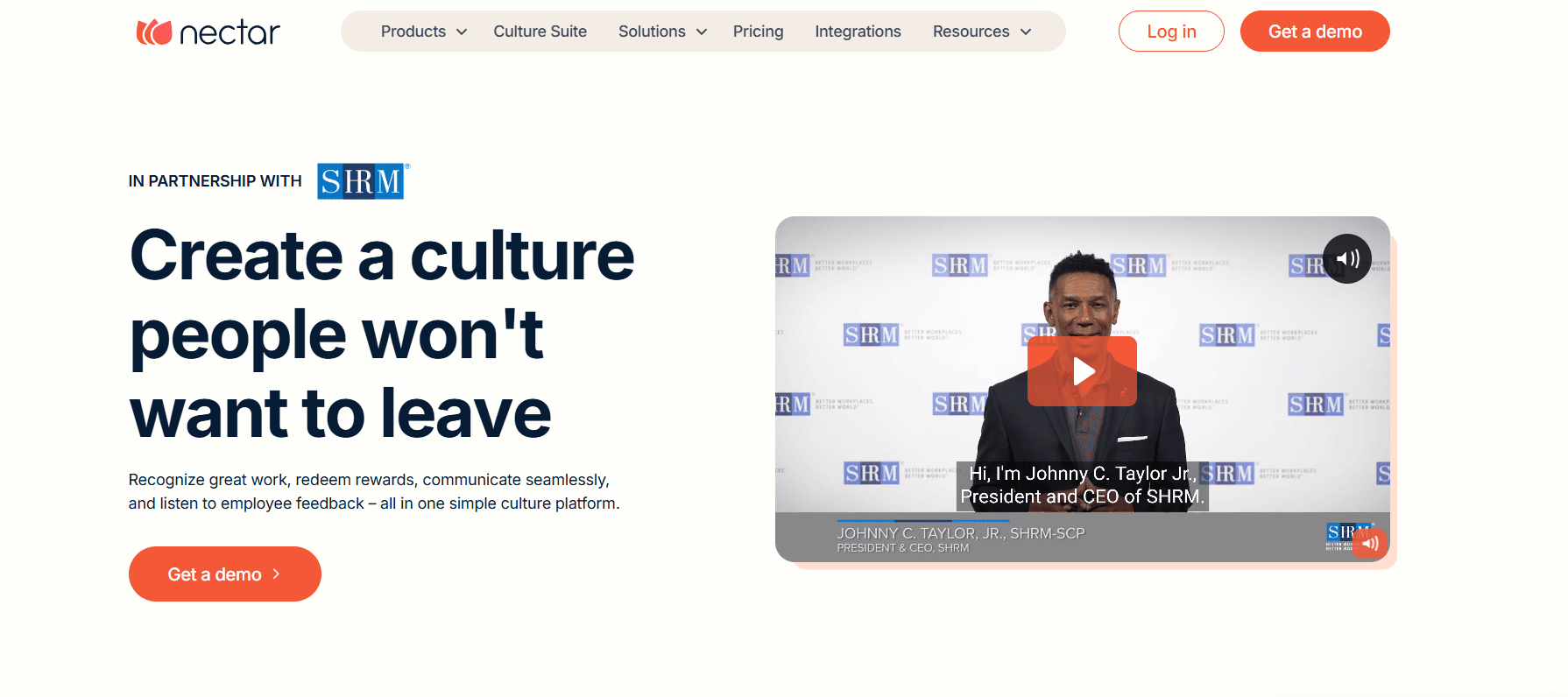
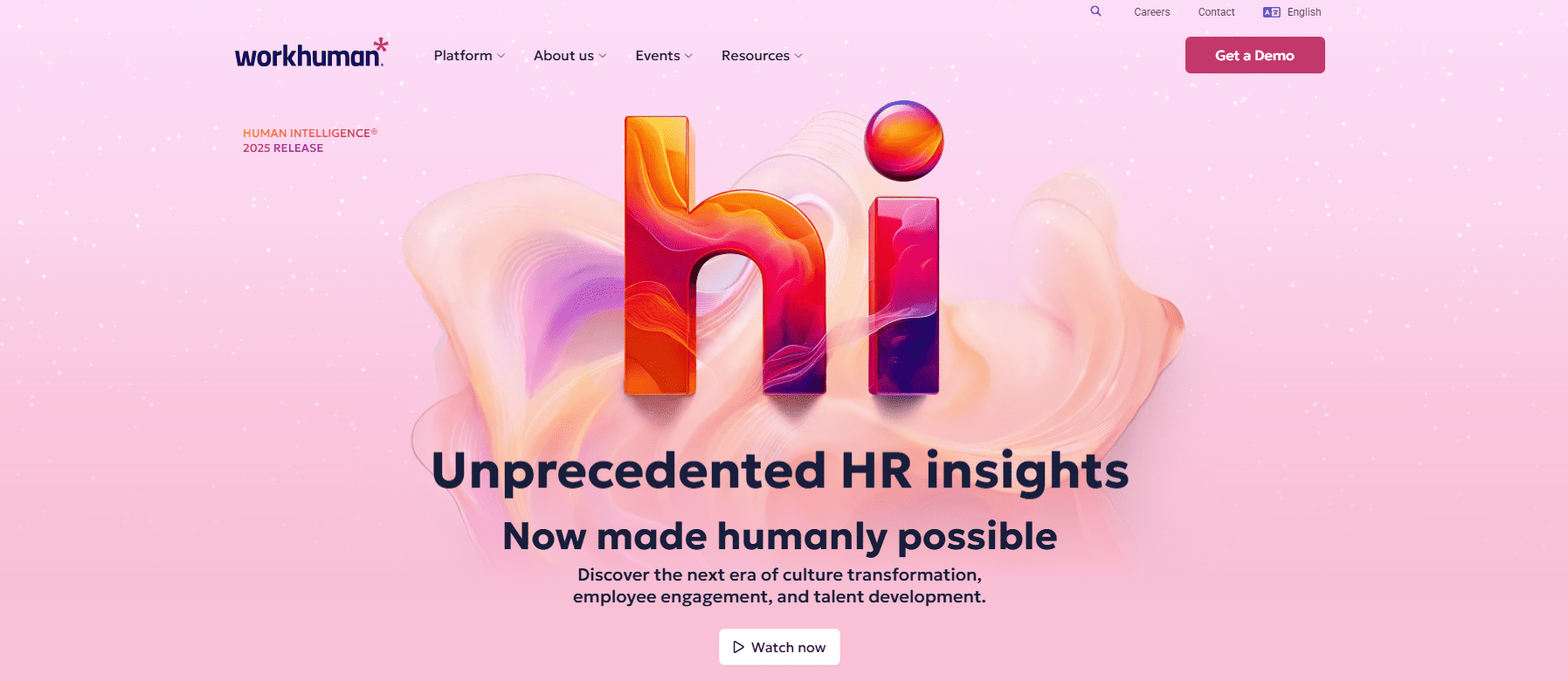
.png?width=1623&height=781&name=image%20(4).png)